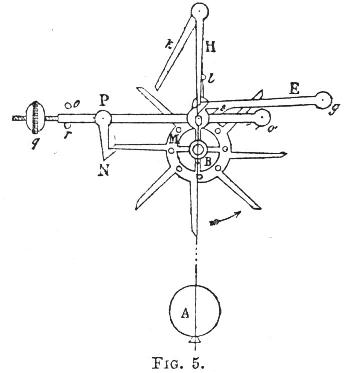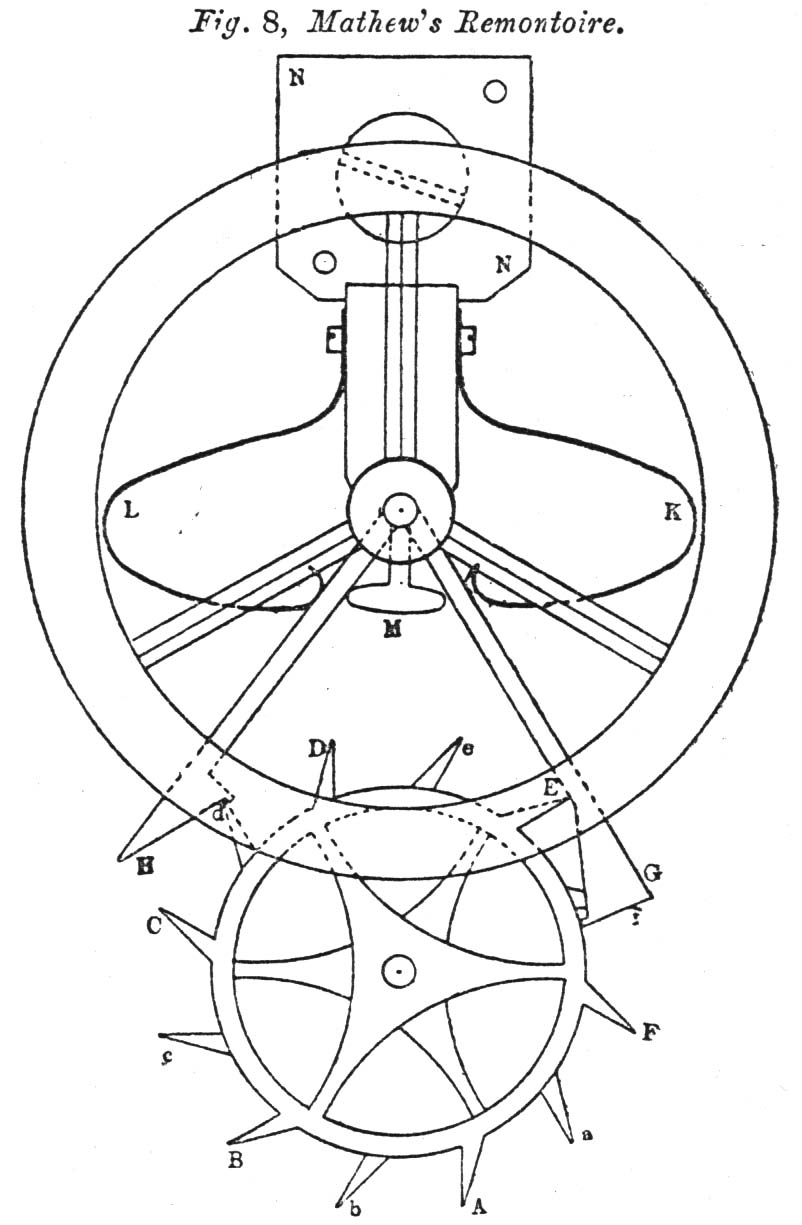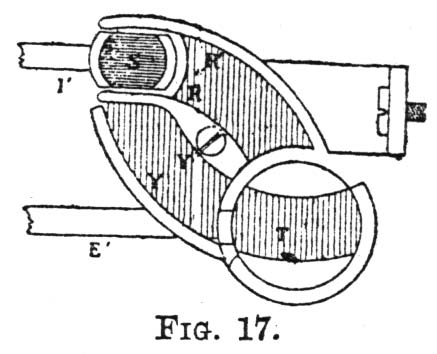
Fig. 1
A Transcription of Harrison M. Frodsham's "Some Material for a Résumé of Remontoires," serialized in The Horological Journal from 1877 to 1879.
The Horological Journal. Vol. ??, No. ?? (February, 1878): 21-23.
[The Horological Journal. Vol. ??, No. ?? (February, 1878): 76-79.]
[Page 76]
(Continued from page 67.)
SOME opinions on remontoires as applied to balance escapements.
SIR E. BECKETT: They have never come to any good and I do not believe that they ever will in watches, although I have myself helped to introduce them into large clocks, where it was pronounced equally certain that they must fail. But the conditions are essentially different in so many respects, that no inference can be drawn from one which can be of any use for the other . . . . Nothing is more requisite to impress on horological inventors than this, that nothing more complicated than what is now in use has the smallest chance of being adopted.1
SAUNIER 2 discussing Breguet's abandonment of the escapement described [on] page 67, though it was and is one of his best titles to fame (it gave no better results than the ordinary chronometer escapement, and did not even sustain these, notwithstanding it was executed as probably only he could have made it), concludes "that it was because experience showed that no force is really constant, that every escapement is a combination of terms which alter with time." . . . And "that success in the future equally with the present is assured to that one which presents the fewest number of terms, and the combination the least susceptible of modification by usage."
SAUNIER is altogether against balance remontoires. In his "Grand Traité d'Horlogerie Moderne," he does not give a single example; he points out how they waste force and says that the search after constant force in a spring is chimerical.
"Theory and experience agree in proving that, save in a small number of exceptional cases, the employment of these expensive arrangements, difficult both to make and keep in repair, offers in chronometrical machines of small dimensions, inconveniences which are balanced by no serious advantage.["] 3
CHARLES FRODSHAM 4 : Perfect timekeeping by the remontoire escapement is "the watchmaker's philosopher's stone." "The remontoire is as false in its results as its principles are alluring and plausible; it has its uses in large turret clocks, but is quite abandoned by the experienced chronometer maker."
Clearly no new escapement will turn out those now in use, unless it is more economical, i.e., it must either give better timekeeping (than the best of them) at the same cost, or equal by good timekeeping at a less cost.
In HANRIOT'S, 5, BROSSE'S, 6, and VERITE'S, 7 one maintainer pressing in the same direction gives impulse in both directions by lifting action on either side of a pivoted roller, according to the direction in which the pendulum or balance is moving. The unlocking takes place just before the line of centres.
Figs. 1, 2, 3, & 4, Hanriot's Remontoire

Fig. 1

Fig. 2

Fig. 3
[Page 77]
[This is a half-size copy of Fig. 1 for easier reference from the text.]

HANRIOT'S (figs. 1, 2, 3, and 4): c c is the maintainer (a pin i at the end of it acts on j, the pivoted roller of the balance e, as said above); it is armed by one of the little rollers q q q of the train wheel a acting on the branch o, and is kept in that position by the wheel being then locked by one of the cogs p p p, on a hook at i (fig. 2).

Fig. 4
Fig. 4 saves further explanation.
The rewinder and the balance move at the same time, the impulse is dependent on the train running always at the proper speed to allow of the maintainer falling down to its banking before the little roller comes into connection with it, to re-arm it.
Figs. 5, 6, & 7, Verite's Remontoire

Fig. 5
[This is a half-size copy of Fig. 5 for easier reference from the text.]

VERITE'S avoids this by making the maintainer unlock the train when it has fallen and given impulse, i.e., the maintainer E, pivoted at q, falls upon the arm o of the detent P H, and releases the star-wheel M.
The maintainer is armed by the centre pins of M acting on arms S. The pendulum is supposed to have its centre of movement at B, and receives its impulse from pin F of the maintainer acting on the pivoted roller C. Fig. 7 is the stop behind detent H, on which the maintainer is locked ready for impulse.

Fig. 6 [and] Fig. 7.
MATHEW'S 8 idea was to do without a balance spring, the impulse springs L K being intended to take its place as well as act as maintainers.
Fig. 8, Mathew's Remontoire

Fig. 8.
[This is a half-size copy of Fig. 8 for easier reference from the text.]

M is a cranked part of the balance arbor; tooth d of the under wheel has armed L by lifting pallet H, and is locking on the nib at the nd; the balance moving on, unlocks d, goes on as far as it can (meanwhile tooth E of the upper wheel arms K through pallet G), and on its return, receives the impulse due to [Page 78 starts here] H, being able to fall down to the position of a in the figure, and vice versâ for the reverse impulse.
Fig. 9, Moenk's Remontoire

Fig. 9.
[This is a half-size copy of Fig. 9 for easier reference from the text.]

MOENK'S [the "oe" in Moenk is an oe dipthong] (fig. 9) shows W M M' k, the maintainer, locked up ready for impulse to pendulum P P, by a half pin under the hook of detent A, and the train-wheel locked - after having armed the maintainer by the action of one of its teeth on the half-round pin at M' - on detent D D. Pendulum P P, moving towards the left, will lift detent A by means of a pin and release the maintainer, which will fall with the pendulum on its descent and give impulse; arm k will fall against the auxiliary spring s and be stopped for a moment, and so cease its connection with the pendulum before coming in contact with detent D D and unlocking the train.
Fig. 10, Fleury's Remontoire

Fig. 10.
[This is a half-size copy of Fig. 10 for easier reference from the text.]

FLEURY'S (fig. 10) shows the pendulum P P moving to the left, having just unlocked the train by pin b, moving cylinder C, and so allowing the upright tooth to escape from the outsid, and the long tooth to lock inside; one of the pins, therefore, no longer supports the maintainer at R. When the pendulum descends, the maintainer o R m will fall with it, restoring its lost force by the weight of o acting through beat-pin m.
Figs. 11 & 12, Tavan's Remontoire

Figs. 11 & 12.
[This is a half-size copy of Figs. 11 and 12 for easier reference from the text.]

TAVAN'S (figs 11 & 12 9). The maintainer is the spiral spring s on the arbor of the impulse lever a b q; it operates at every other vibration, the arming (by the wheel teeth) takes place during the intermediate ones. The escape-wheel moves nearly a whole space at the arming and only just slips off P on to p at the other, when q escapes and impels the balance by o on impulse pallet t.
[This is a half-size copy of Fig. 13, De Chalonge's remontoire, for easier reference from the text.]

DE CHALONGE'S (figs. 13, 14, and 15) : "If the pendulum be moved to the right (fig 13) it draws with it, by the pin X, [Page 79 starts here] the piece E E' G, pivoted at F. The second piece B B' equally movable on a centre and under the action of the ball z follows the movement. As a result, the tooth A of the 'scape-wheel is released, and that wheel begins to move, then one of the lifting pins in the centre by means of the circular arm o', o i raises the ball z, and sends it on M (a small disc with a groove turne din it), fixed on an upright (figs. 13 and 14). While the ball is making the round of M Y V, to retake its place on R R, B B and o', o i will have resumed their positions (shown in fig. 13). B' heavier than B has refallen on H, while the ball was still on M. The pendulum in its ascent had E E by means of B B, urged by the ball z, whereas, it descends weighted by E E', which thus restores its lost momentum.
"The two arms i i of o i (fig. 13 and 15) are sloped slightly on the inside, and at the position ready for launching the ball z, they incline towards M. 10
Figs. 13, 14, & 15, De Chalonge's Remontoire

Figs. 13, 14, & 15.
Figs. 16 & 17, De Chalonge's Remontoire [scond arrangement]

Fig. 16.

Fig. 17.
[This is a half-size copy of Fig. 16 for easier reference from the text.]

"In the other arrangement 11 (figs. 16 and 17) in order to have the levers for releasing the 'scape-wheel (D), and for raising the ball (z) on the same axis (K), the inventor places a ball o on the arm E, the ball being hung from the plate by a thread."
The piece u (which at a certain moment receives z) makes balance, and by its weight obliges the arm E to rest against the ball o. After having pushed the pendulum to the left the ball z rolls off on to R R', to fall on T (fig 4 [sic]) on the piece u. The ball z then adds its weight to that of u to raise o and so unlock 'scape-wheel D, this wheel then moves a space, one of the lifting pins at its cetnre, depresses E and thus raises the ball z which is in I on u at the end of E'; z is then launched on to Y Y and rests again on S on I'.
Meanwhile E is banking against ball o by the weight of u.
1 Clock and Watchmaking, p. 315, 6th Edition.
2 Revue Chronométrique, vol. vi., page 183.
3 Grand Traité d'Horlogerie Moderne, page 3.
4 A few facts, &c., 1862.
5 Soc. of Arts Trans., 1834, vol. 50, page 112, plate 3. Awarded a silver medal. Hanriot was Director of the Mâcon Horological School.
6 Revue Chronométrique, vol. vi., page 128.
7 Revue Chronométrique, vol. x., page 398.
8 [Presumably UK patent] Specification 3125. A.D. 1808.
9 Descrip. des Eschapp. Geneva, page 48, date about 1804.
10 Revue Chronométrique, page 252-3, vol. viii.
11 Revue Chronométrique, page 299, vol. viii.
[Footnotes. In the original these footnotes were arranged by column and indicated by asterisks and daggers. They have been gathered and numbered here.]
Frodsham's
"Some Material for a Résumé of Remontoires,"
is in the public domain.
The reprints of them here are dedicated to the
Public Domain.
Important disclaimers of warranty
and liability in the presentation of public domain material.
The rest of this page is
copyright © 1998, 1999 and 2004
by David M. MacMillan
This work is licensed under a
Creative Commons License.
lemur.com is a service mark of
David M. MacMillan
and Rollande Krandall.
Other trademark
recognition.
Presented originally by lemur.com.SM